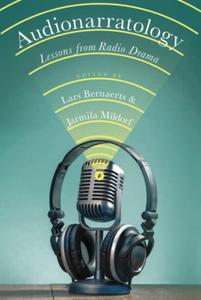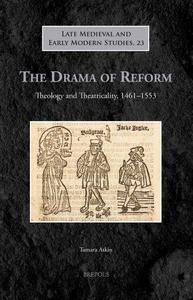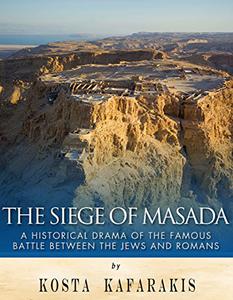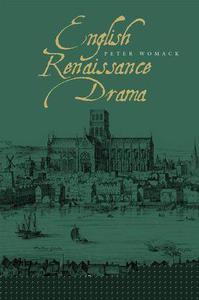

E-Books → Audionarratology Lessons from Radio Drama
Published by: voska89 on 24-08-2022, 02:11 |  0
0

Audionarratology: Lessons from Radio Drama By Lars Bernaerts (editor), Jarmila Mildorf (editor)
2021 | 248 Pages | ISBN: 081421472X | PDF | 3 MB
Radio drama has been around for more than one hundred years and is still vibrant in many countries. A narrative-dramatic genre and art form in its own right, radio drama has traditionally crossed medial and generic boundaries and continues to do so in our age of digitization. Audionarratology: Lessons from Audio Drama, edited by Lars Bernaerts and Jarmila Mildorf, explores radio drama from a narratological angle. The contributions cover key questions surrounding audiophonic meaning-making, storyworld creation, mediation, focalization, suspense, unreliability, and ambiguity as well as the relationship between script and performance, seriality, antinarrative tendencies, and radio drama's political implications now and in its early days. The book thus explores the interplay between sound, voices, music, language, silence, electroacoustic manipulation, and narrative structures. Providing examples from American, Australian, British, Dutch, and German radio drama-such as I Love a Mystery, The War of the Worlds, and The Hitchhiker's Guide to the Galaxy-this book has important insights for scholars working in transmedial narratology, media studies, literary and cultural studies, theatre and performance studies, and communication studies as well as for practitioners and lovers of radio drama alike.
E-Books → The Drama of Reform Theology and Theatricality, 1461-1553
Published by: voska89 on 15-08-2022, 06:56 |  0
0

The Drama of Reform: Theology and Theatricality, 1461-1553 By Tamara Atkin
2013 | 210 Pages | ISBN: 250354651X | PDF | 2 MB
'The Drama of Reform' establishes the impact of late medieval and early modern religious reform on dramaturgy. Taking an interdisciplinary approach, it examines the interactions between theatricality and theology across a range of different plays including the Croxton 'Play of the Sacrament', 'Jacke Jugeler', John Bale's 'Three Laws', and Lewis Wager's 'Life and Repentaunce of Mary Magdalene'. Tracing the development of arguments concerning the interpretation of the sacraments, the relationship between priests and players, and the use and abuse of imagery and drama in religious worship, 'The Drama of Reform' draws on a rich variety of contextual materials including liturgical texts, heresy trial accounts, dramatic treatises, polemical tracts, and religious laws. Focussed on the period between Archbishop Arundel's Constitutions in the fifteenth century and Archbishop Cranmer's second Book of Common Prayer in the sixteenth, 'The Drama of Reform' explores the phenomenological similarities between drama and certain religious rites, notably the eucharist, and proposes that religious reform prompted attempts to reform dramaturgy. In presenting this analysis, the author argues that while drama continued to function as dramatic propaganda, efforts to initiate new modes of playing were only partially successful.
E-Books → A Guide to Ancient Greek Drama, 2nd Edition
Published by: voska89 on 15-08-2022, 03:00 |  0
0

A Guide to Ancient Greek Drama, 2nd Edition
by Ian C. Storey, Arlene Allan
English | 2014 | ISBN: 1118455126 | 352 Pages | True AZW3 | 3.14 MB
E-Books → Immaterial Culture Literature, Drama and the American Radio Play, 1929-1954 (Cultural Interactions Studies in the Relationshi
Published by: voska89 on 10-08-2022, 21:19 |  0
0

Immaterial Culture: Literature, Drama and the American Radio Play, 1929-1954 (Cultural Interactions: Studies in the Relationship between the Arts) By Harry Heuser
2013 | 368 Pages | ISBN: 3034309775 | PDF | 3 MB
Immaterial Culture engages with texts that are now largely unread and dismissed as trivial or dubious: the vast body of plays - thrillers, narrative poetry, comedy sketches, documentaries and adaptations of literature and drama - that aired on American network radio during the medium's so-called golden age. For a quarter century, from the stock market crash of 1929 to the introduction of the TV dinner in 1954, radio plays enjoyed an exposure unrivalled by stage, film, television and print media. As well as entertaining audiences numbering in the tens of millions for a single broadcast, these scripted performances - many of which were penned by noted novelists, poets and dramatists - played important and often conflicting roles in advertising, government propaganda and education. Reading these fugitive and often self-conscious texts in the context in which they were created and presented, the author considers what their neglect might tell us about ourselves, our visual bias and our attitudes toward commercial art and propaganda. The study's ample scope, its interdisciplinary approach and its insistence on the primacy of the texts under discussion serve to regenerate the discourse about cultural products that challenge the way we classify art and marginalise the unclassifiable.
E-Books → The Siege of Masada A Historical Drama of the Famous Battle Between the Jews and Romans
Published by: voska89 on 5-08-2022, 01:41 |  0
0

The Siege of Masada: A Historical Drama of the Famous Battle Between the Jews and Romans by Kosta Kafarakis
English | July 5, 2015 | ISBN: 1514831678 | 50 pages | EPUB | 1.34 Mb
*Includes pictures of Masada and other important places and events *Includes a table of contents *Includes a bibliography of other books about Masada "Since we long ago resolved never to be servants to the Romans, nor to any other than to God Himself, Who alone is the true and just Lord of mankind, the time is now come that obliges us to make that resolution true in practice ... We were the very first that revolted, and we are the last to fight against them; and I cannot but esteem it as a favor that God has granted us, that it is still in our power to die bravely, and in a state of freedom." - Elazar ben Yair Many Westerners have never even heard of the Siege of Masada, and those who have may simply know it as an obscure reference to a minor battle fought in a remote location of the Roman world. By contrast, virtually all Israeli school children know the story of Masada as a premier example of nationalistic pride. According to historian Klara Palotai, "Masada became a symbol for a heroic 'last stand' for the State of Israel and played a major role for Israel in forging national identity" Indeed, the heroic story of a small band of fighters facing incalculable odds has many elements that are reminiscent of both the Battle of Thermopylae and the Battle of the Alamo. The refrain "Masada shall not fall again," coined in a poem on the subject by Yitzak Lamdan, became a cry of resolve in battle for Israeli soldiers in the 20th century, just as the cry of "Remember the Alamo" had galvanized Americans. For decades, the Israelite military used the site of Masada as the location for swearing in their new recruits, and the choice of the site was obviously designed to evoke within the new soldiers a deep sense of connection with their national history. The Siege of Masada was the final battle in a long series of fights that constituted the First Jewish-Roman War. The Roman Empire had established control over the region in the 1st century BCE, when the Roman proconsul Pompey the Great took control of Jerusalem and ceremonially defiled their temple by entering it. This mix of political control and religious desecration was a contentious issue for the Judeans throughout the Roman period, and militant activists opposed to Roman rule, often espousing strongly held religious beliefs, frequently developed large followings to challenge the Roman authorities. This led to multiple violent clashes between the Judeans and the Romans, and the First Jewish-Roman War (66-73 CE) was one such clash (albeit on a larger scale than most). The Roman troops marched through and made their military might felt, first in the northern region of Galilee, then down the coast where they finally laid siege to the capital city of Jerusalem. This left three Roman fortress outposts, including Masada, that had been built by Herod the Great but had been taken over by various Judean factions. Masada was the last of these fortresses that the Romans attacked and proved the most difficult for them to seize, but seize it they did. However, what made this battle qualitatively different from most was not just the difficulty Rome had in retaking control of it with incredibly disproportional military equipment and numbers, but also the actions of the Judean defenders. In the final hours of the battle, just as the Romans were about to breach the walls of the city, the defenders gathered together and committed mass suicide, rather than being killed or taken captive by the Romans. The Siege of Masada: A Historical Drama of the Famous Battle Between the Jews and Romans is a historical drama that portrays the famous battle from the standpoint of a fictional survivor.
E-Books → A Companion to Restoration Drama
Published by: voska89 on 5-08-2022, 00:41 |  0
0

A Companion to Restoration Drama By
2001 | 469 Pages | ISBN: 0631219234 | PDF | 9 MB
This Companion illustrates the vitality and diversity of dramatic work 1660 to 1710. Twenty-five essays by leading scholars in the field bring together the best recent insights into the full range of dramatic practice and innovation at the time.Introduces readers to the recent boom in scholarship that has revitalised Restoration drama Explores historical and cultural contexts, genres of Restoration drama, and key dramatists, among them Dryden and Behn Content: Chapter 1 The Post?1660 Theatres as Performance Spaces (pages 1-18): Edward A. LanghansChapter 2 Restoration Dramatic Theory and Criticism (pages 19-35): Paul D. CannanChapter 3 Theatrical Regulation during the Restoration Period (pages 36-52): Matthew J. KinservikChapter 4 Libertinism and Sexuality (pages 53-68): Maximillian E. NovakChapter 5 The Restoration Actress (pages 69-91): Deborah Payne FiskChapter 6 Masculinity in Restoration Drama (pages 92-108): Laura J. RosenthalChapter 7 Images of Monarchy on the Restoration Stage (pages 109-125): Jessica MunnsChapter 8 Restoration Drama and Politics: An Overview (pages 126-139): Susan J. OwenChapter 9 Restoration Drama and Social Class (pages 140-160): Aparna DharwadkerChapter 10 Race, Performance and the Silenced Prince of Angola (pages 161-176): Mita ChoudhuryChapter 11 Restoration Drama after the Restoration: The Critics, the Repertory and the Canon (pages 177-192): Brian CormanChapter 12 Heroic Drama and Tragicomedy (pages 193-210): Derek HughesChapter 13 Restoration Comedy (pages 211-227): J. Douglas CanfieldChapter 14 Tragedy and Varieties of Serious Drama (pages 228-242): Jean I. MarsdenChapter 15 London Theatre Music, 1660-1719 (pages 243-273): Todd S. GilmanChapter 16 Shakespeare and Other Adaptations (pages 274-290): Sandra ClarkChapter 17 Rakes, Wives and Merchants: Shifts from the Satirical to the Sentimental (pages 291-308): Kirk CombeChapter 18 William Davenant and John Dryden (pages 309-325): Richard KrollChapter 19 'Still on the Criminal's Side, against the Innocent': Etherege, Wycherley and the Ironies of Wit (pages 326-339): Robert MarkleyChapter 20 'Who Vices Dare Explode': Thomas Shadwell, Thomas Durfey and Didactic Drama of the Restoration (pages 340-354): Christopher J. WheatleyChapter 21 Otway, Lee and the Restoration History Play (pages 355-377): Paulina KewesChapter 22 Elkanah Settle, John Crowne and Nahum Tate (pages 378-395): Don?John DugasChapter 23 Two Female Playwrights of the Restoration: Aphra Behn and Susanna Centlivre (pages 396-411): Cynthia LowenthalChapter 24 William Congreve and Thomas Southerne (pages 412-428): Miriam HandleyChapter 25 Sir John Vanbrugh and George Farquhar in the Post?Restoration Age (pages 429-445): John Bull
E-Books → American Drama In Dialogue, 1714-Present
Published by: voska89 on 3-08-2022, 23:12 |  0
0

Jacqueline Foertsch, "American Drama: In Dialogue, 1714-Present"
English | 2017 | ISBN: 1137605278, 1137605286 | EPUB | pages: 291 | 0.7 mb
An essential introductory textbook that guides students through 300 years of American plays, as well as their remarkable engagement with texts from across the Atlantic. Divided into seven historical periods, Jacqueline Foertsch offers unique overviews of 38 American plays and their reception, from Robert Hunter's Androboros (c.1714) to Lin-Manuel Miranda's Hamilton (2015). Each historical section begins with an overseas play that proved influential to American playwrights in that period, demonstrating to students an astonishing dialogue taking place across the Atlantic.
E-Books → English Renaissance Drama
Published by: voska89 on 2-08-2022, 17:42 |  0
0

English Renaissance Drama By
2006 | 326 Pages | ISBN: 063122629X | PDF | 2 MB
The book considers the London theatrical culture which took shape in the 1570s and came to an end in 1642.Places emphasis on those plays that are readily available in modern editions and can sometimes to be seen in modern productions, including Shakespeare. Provides students with the historical, literary and theatrical contexts they need to make sense of Renaissance drama. Includes a series of short biographies of playwrights during this period. Features close analyses of more than 20 plays, each of which draws attention to what makes a particular play interesting and identifies relevant critical questions. Examines early modern drama in terms of its characteristic actions, such as cuckolding, flattering, swaggering, going mad, and rising from the dead. Content: Chapter 1 The Set?Up (pages 15-45): Chapter 2 Background Voices (pages 47-92): Chapter 3 The Writers (pages 93-124): Chapter 4 Key Plays (pages 125-260): Chapter 5 Actions that A Man Might Play (pages 261-311):
E-Books → Equestrian Drama An Anthology of Plays
Published by: voska89 on 26-07-2022, 19:50 |  0
0

Equestrian Drama: An Anthology of Plays
English | 2023 | ISBN: 036722271X | 343 Pages | PDF (True) | 15 MB
It includes four annotated plays: Timour the Tartar by Matthew G. Lewis, The Battle of Waterloo by J. H. Amherst, Mazeppa by Henry M. Milner, and The Whip by Henry Hamilton and Cecil Raleigh. An introduction precedes the collection, providing the information necessary to understand and contextualize the genre and the plays as both written and performance texts, and within the time period of their original productions, as well as within the larger histories of theatre and equestrian entertainments. Additional related plays are identified, excerpted, and explored, providing readers with a wide range of examples to better understand the development and significance of this unique form of popular theatre. Also identified and explored are significant contributions made to stage technology and design by the patented stage machinery designed for the production of the mechanized form of equestrian drama, which became popular in the late nineteenth century.
Music → DREAMTIDE - Drama Dust Dream (2022) [24Bit-48kHz] FLAC
Published by: Emperor2011 on 21-07-2022, 18:57 |  0
0
![DREAMTIDE - Drama Dust Dream (2022) [24Bit-48kHz] FLAC DREAMTIDE - Drama Dust Dream (2022) [24Bit-48kHz] FLAC](https://img75.pixhost.to/images/14/295657606_e54gg5o3xmxr.png)
Format: FLAC | 1942 Kbps
Album: Drama Dust Dream
Artist: DREAMTIDE
Genre: Rock
Date/Year: 2022



